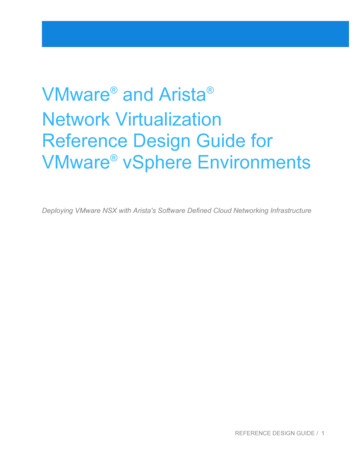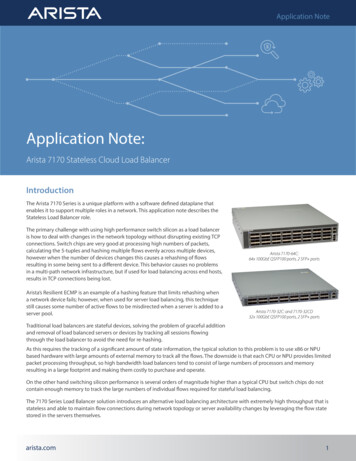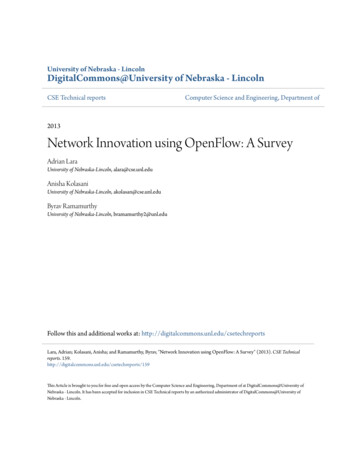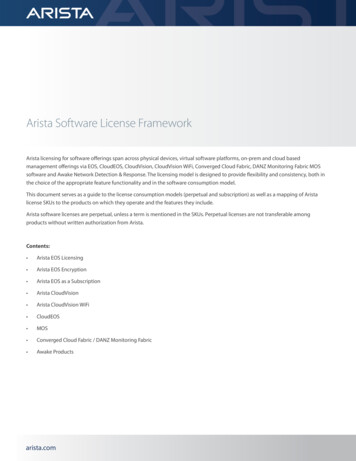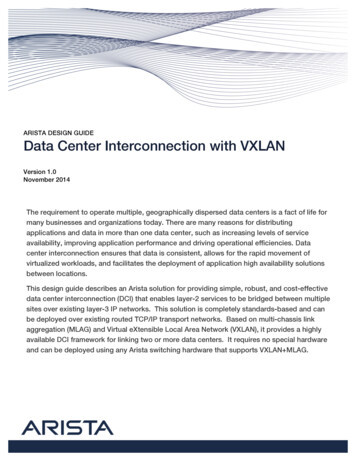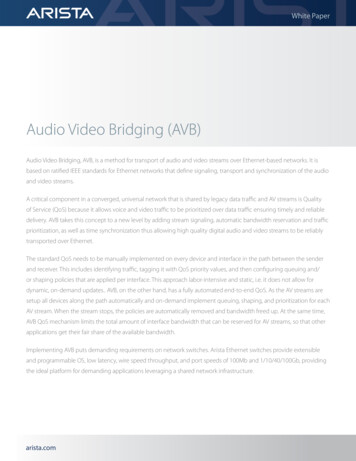
Transcription
White PaperAudio Video Bridging (AVB)Audio Video Bridging, AVB, is a method for transport of audio and video streams over Ethernet-based networks. It isbased on ratified IEEE standards for Ethernet networks that define signaling, transport and synchronization of the audioand video streams.A critical component in a converged, universal network that is shared by legacy data traffic and AV streams is Qualityof Service (QoS) because it allows voice and video traffic to be prioritized over data traffic ensuring timely and reliabledelivery. AVB takes this concept to a new level by adding stream signaling, automatic bandwidth reservation and trafficprioritization, as well as time synchronization thus allowing high quality digital audio and video streams to be reliablytransported over Ethernet.The standard QoS needs to be manually implemented on every device and interface in the path between the senderand receiver. This includes identifying traffic, tagging it with QoS priority values, and then configuring queuing and/or shaping policies that are applied per interface. This approach labor-intensive and static, i.e. it does not allow fordynamic, on-demand updates. AVB, on the other hand, has a fully automated end-to-end QoS. As the AV streams aresetup all devices along the path automatically and on-demand implement queuing, shaping, and prioritization for eachAV stream. When the stream stops, the policies are automatically removed and bandwidth freed up. At the same time,AVB QoS mechanism limits the total amount of interface bandwidth that can be reserved for AV streams, so that otherapplications get their fair share of the available bandwidth.Implementing AVB puts demanding requirements on network switches. Arista Ethernet switches provide extensibleand programmable OS, low latency, wire speed throughput, and port speeds of 100Mb and 1/10/40/100Gb, providingthe ideal platform for demanding applications leveraging a shared network infrastructure.arista.com
White PaperAVB AdvantagesAudio Video Bridging, AVB, allows businesses to take advantage of a shared Ethernet network infrastructure. This can imply sharedcost model and savings in addition to unification and simplification of the overall network infrastructure. Ethernet is the de-factostandard used everywhere today, so that businesses can take advantage of networks and cabling that is already in place. Being sowidely deployed, Ethernet is a well known, mature, and well-supported technology. The cost per port and bandwidth keeps goingdown for Ethernet switches, while port speed, transport latency, and overall switch throughput keep improving.Ethernet is inherently very scalable and flexible and also the standard used in the largest data centers today. It is an ideal technologyfor all sizes AVB deployments. All kinds of communication streams are supported by default: one-to-one, one-to-many, and manyto-one. With just one connection to a single Ethernet switch, an AVB end point can setup any of the above communications withany of the other AVB end points connected to the same AVB domain. An AVB domain can be a single switch or many Ethernetswitches connected together allowing thousands of AVB end points to communicate. Expanding an AVB domain can be as simple asconnecting additional Ethernet switches with zero impact to the existing AVB end points and network connectivity.To ensure interoperability between different vendors, AVB is based on a set of ratified IEEE standards. In addition, AVnu alliance is anindustry alliance that has been formed in order to promote AVB and ensure compatibility. AVnu Alliance is also responsible for thecertifications of AVB devices, which are conducted at the University of New Hampshire Interoperability Lab.Delay-sensitive digital AV traffic requires a low latency, low jitter network. Per the standards, latency end-to-end for a Class-A AVstream must be within 2 ms. Arista Ethernet switches belong to the category of ultra low latency, best in breed, high-end data centerproducts.Time synchronization between all devices within an AVB domain allows for deterministic delivery of AVB streams. One of theimportant concerns that is addressed by the Generalized Precision Time Protocol (gPT) is “lip synching”, i.e. synchronization betweenaudio and video streams. A gPTP master clock becomes a reference clock for all devices in the AVB domain - this allows the AVBend points to present the AV frames at the receiving end at the correct time. Because of built-in high precision IEEE 1588 PTPclocks, Arista switches can act as gPTP masters or serve as backup for external gPTP master in cases where the primary gPTP masterbecomes unavailable.AVB was designed to be “plug and play” allowing for rapid deployment of an AVB network. End points and AVB- capable switchesautomatically and dynamically implement stream signaling, quality of service, time synchronization, and stream delivery. A thirdparty central AVB controller can be used for automatic discovery and enumeration of end points, and for stream setup and teardown.How Audio Video Bridging WorksCore components of AVB are Time Synchronization, Signaling, Transport Protocol, AVB Systems, Quality of Service, and ControlProtocol. This white paper will focus on the operation of Time Synchronization, Signaling, and Transport Protocol in order to illustratethe basic AVB operation.Time SynchronizationgPTP ensures that all devices in the AVB domain have synchronized clocks to ensure consistent delivery of time- sensitive AVstreams. Having synchronized clocks helps prevent “out of sync” issues, such as “lip sync” problem where audio and video are notsynchronized. If an external gPTP device is not available, the Arista switch can act as the gPTP master for the domain Switch interfaces towards the gPTP Grand Master are called master interfaces, and interfaces toward the gPTP devicesthat are not Grand Masters are called slave interfaces gPTP device priority can be manually set to predictably decide primary and backup gPTP Grand Mastersarista.com
White Paper Initial and all subsequent gPTP Grand Master elections are completed automatically Switch’s interface must run gPTP in order to be declared capable of forwarding AVB trafficSignalingAVB operation is efficient because only stream signaling is send to all AVB interfaces within the AVB domain. The AV stream itselfdoesn’t start until the negotiation between the Talker and Listener is completed. The AV stream is then transported only betweenthose two end points.1. AVB signaling and stream setup are accomplished using Multiple Stream Reservation Protocol (MSRP). To allow all otherend points to automatically learn about available streams, the Talker sends advertisements of all locally available streams,each with a unique stream ID. These advertisements include data rate required, class, stream priority, and other parameters2. The switch forwards the Talker advertisements out all AVB capable interfaces that have enough available bandwidth toaccommodate these streams3. The Talker advertisements are received by the Listenersarista.com
White Paper1. The Listener needs a way of communicating to the Talker what streams it’s interested in receiving. It uses the samesignaling protocol as the Talker - Multiple Stream Reservation Protocol (MSRP). After learning about the available streams,the Listener sends Listener advertisements for specific streams it wants to receive.2. The switches will forward the Listener advertisements back to the Talker on the interface where the Talker advertise wasoriginally seen, and also reserve bandwidth along the path for the stream specified The switch connected to the Listener will also map the stream’s unique multicast MAC address to Listener’sinterface The Listener also sends “Listener Ready” advertisement back to the Talker3. After learning about available streams, the Listener sends its own advertisements for the specific streams it wants toreceive4. The switches will forward the Listener advertisements back to the Talker on the interface where the Talker advertise wasoriginally seen, and also reserve bandwidth along the path for the stream specified The switch connected to the Listener will also map the stream’s unique multicast MAC address to Listener’sinterface The Listener also sends “Listener Ready” advertisement back to the TalkerTransportStream Transport Protocol converts AV frames in different format, such as Firewire/IEEE 1394 to Ethernet frames that can then betransported over Ethernet networks.1. The Talker starts streaming the requested stream using the stream transport protocol. The Talker and Listener will also send periodic advertisements during stream transmission to ensure the endpointsare still reachable.2. The switches in the AVB domain will forward the Talker’s stream only toward the Listener’s port.arista.com Multiple Listeners can subscribe to the same Talker stream A single Listener can also subscribe to multiple streams Smart AVB switches along the stream’s path automatically reserve bandwidth and prioritize AVB traffic ensuringreliable and predictable end-to-end transport of the streams
White PaperAVB and AristaAVB is supported on Arista 7150 and 7500E switches. Arista switches offer low latency and wire speed performance, making theswitches ideal for delay-sensitive applications such as digital audio and video. Arista Extensible Operating System (EOS) softwareis an extensible and programmable switch OS. JSON-based eAPI, SDK, and Python Scripting are available to allow for advancedintegration and network visibility, automation, and for building tools for operations teams. By leveraging Arista’s EOS extensibilityand programmability, operations teams with minimum network experience can monitor and troubleshoot networks and AVB. Asingle Arista switch can provide between 24 - 1152 AVB interfaces at speeds of 100Mb and 1/10/40/100Gb per interface.Arista is a member of the AVnu Alliance http://www.avnu.org/about us/our members, which promotes AVB standards, the adoptionof the standards, and interoperability testing.arista.comArista 7100Arista 7500E 100Mb, 1/10/40Gb Ethernet ports 100Mb, 1/10/40/100Gb Ethernet ports Ultra Low Latency: 350 – 380ns Class leading latency from 3.5us 960 Million Packets per second 14.4 Billion Packets per second Low Jitter for Unicast and Multicast 3.84Tb of capacity for each line card slot IEEE 1588 PTP with high precision clock IEEE 1588 PTP with high precision clock
White PaperSummaryThe trend is to deploy a universal network for all applications including Voice over IP, Video over IP, and Audio Video Bridging (AVB) inorder to take advantage of a shared network infrastructure and shared cost. The flexibility and scalability of Ethernet allow for smalland large AVB deployments and seamless expansion without down time. The combination of low latency, high throughput Ethernetswitches, and fully automated end-to-end Quality of Service ensures timely and reliable delivery of delay-sensitive AVB streams.Generalized Precision Time Protocol (gPTP) ensures that all devices within the AVB domain are time-synchronized. A 3rd partycentral AVB controller can be used to discover and manage the AVB end points, while also allowing the operations teams to setupand tear down AVB streams within the domain. AVB is standards-based ensuring interoperability between different vendors.Arista offers both fixed configuration and modular switches that support AVB. The Arista AVB Ethernet switches provide low latency,wire speed performance, and also have built-in, high precision PTP clocks. Arista’s Extensible Operating System (EOS) provides toolsfor automation, visibility, and integration with external controllers and monitoring tools. Arista’s AVB switches still have all of thecapabilities and features of non-AVB Ethernet switches, allowing other applications to coexist with AVB running on the switches.Santa Clara—Corporate Headquarters5453 Great America Parkway,Santa Clara, CA 95054Phone: 1-408-547-5500Fax: 1-408-538-8920Email: info@arista.comIreland—International Headquarters3130 Atlantic AvenueWestpark Business CampusShannon, Co. ClareIrelandIndia—R&D OfficeGlobal Tech Park, Tower A & B, 11th FloorMarathahalli Outer Ring RoadDevarabeesanahalli Village, Varthur HobliBangalore, India 560103Vancouver—R&D Office9200 Glenlyon Pkwy, Unit 300Burnaby, British ColumbiaCanada V5J 5J8Singapore—APAC Administrative Office9 Temasek Boulevard#29-01, Suntec Tower TwoSingapore 038989San Francisco—R&D and Sales Office1390 Market Street, Suite 800San Francisco, CA 94102Nashua—R&D Office10 Tara BoulevardNashua, NH 03062Copyright 2016 Arista Networks, Inc. All rights reserved. CloudVision, and EOS are registered trademarks and Arista Networksis a trademark of Arista Networks, Inc. All other company names are trademarks of their respective holders. Information in thisdocument is subject to change without notice. Certain features may not yet be available. Arista Networks, Inc. assumes noresponsibility for any errors that may appear in this document. 08/14arista.com
The trend is to deploy a universal network for all applications including Voice over IP, Video over IP, and Audio Video Bridging (AVB) in order to take advantage of a shared network infrastructure and shared cost. The flexibility and scalability of Ethernet allow for small and large AVB deployments and seamless expansion without down time.

